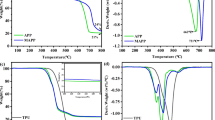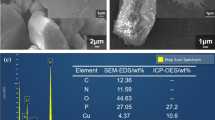Abstract
A design of experiment (DoE) was performed on PMMA-(ammonium polyphosphate/melamine polyphosphate/titanium dioxide) ternary system for optimizing both fire-retardancy properties and thermal stability. The software JMP® was used for this purpose. In poly (methyl methacrylate) (PMMA), progressive substitution of titanium dioxide (TiO2) nanoparticles by melamine polyphosphate (MPP) led to the reduction of the peak of Heat Release Rate (pHRR), whereas the substitution with ammonium polyphosphate (APP) first led to the reduction of pHRR followed by an increase from 9wt% APP onwards. The presence of titanium dioxide led to the increase of the time to ignition (TTI) and thermal stability. Laser Flash Analysis (LFA) measurement showed the heat insulation effect (i.e. low thermal diffusivity) of the residues that have developed during combustion. PMMA-7.5%APP/7.5%TiO2 showed the major increase of the time of combustion alongside with the decrease of pHRR due to the barrier effect. The high carbon monoxide amount released during the cone calorimeter experiment confirmed an incomplete combustion. That sample presented a ceramized structure and the formation of titanium pyrophosphate (TiP2O7) was detected by XRD measurements. TiP2O7 resulted from the reaction between APP and TiO2 upon combustion.
Access this chapter
Tax calculation will be finalised at checkout
Purchases are for personal use only
Preview
Unable to display preview. Download preview PDF.
Similar content being viewed by others
References
Duquesne, S., et al.: Synergism in intumescent systems - a review. In: Advances in the flame retardancy of polymeric materials, Current perspectives presented at FRPM 2005, Berlin, Germany (2007)
Laachachi, A., et al.: Effect of Al2O3 and TiO2 nanoparticles and APP on thermal stability and flame retardance of PMMA. Polymers for Advanced Technologies 17, 327–334 (2006)
Braun, U., et al.: Flame retardancy mechanisms of aluminium phosphinate in combination with melamine polyphosphate and zinc borate in glass-fibre reinforced polyamide 6,6. Polymer Degradation and Stability 92, 1528–1545 (2007)
Bourbigot, S.: Intumescence-based fire-retardants. In: Fire retardancy of polymeric materials, pp. 136–149. CRC press, Boca Raton (2000)
Bourbigot, S., et al.: Recents developments in intumescence-application to polyolefins. In: 9th European Meeting on Fire Retardancy and Protection of materials, Lille, France (2003)
Bourbigot, S., et al.: Recent advances for intumescent polymers. Macromolecular Materials and Engineering 289, 499–511 (2004)
Bourbigot, S., et al.: Intumescence and nanocomposites: a novel route for flame-retarding polymeric materials. In: Morgan, A.B., Wilkie, C. (eds.) Flame retardant polymer nanocomposites, Wiley-Interscience, Hoboken, ch.6 (2007)
University of Central Lancashire. 2008. How do fire retardants work? (updated September 15, 2008), http://www.uclan.ac.uk/scitech/fire_hazards_science/sci_fz_firerets.php (accessed April 21, 2010)
Lomakin, S.M.: Modern Polymer Flame Retardancy. VSP, Boston (2003)
Ciba: Ciba Melapur (2006) (updated 20 April 2010), http://www.ciba.com/melapur (accessed April 21, 2010)
The Fire Retardant Chemicals Association: Flame Retardants - 101: Basic Dynamics Past Efforts Create Future Opportunities in ’Spring Conference. Baltimore, USA’ (1996)
Jahromi, S.A.J., et al.: Failure analysis of 101-C ammonia plant heat exchanger. Engineering Failure Analysis 10, 405–421 (2003)
Bamberger, C.E., et al.: Synthesis and characterization of titanium phosphates, TiP2O7 and (TiO)2P2O7. Journal of the Less-Common Metals 134, 201–206 (1987)
Bourson, P., et al.: L’application de la spectrométrie Raman portable à l’identification des polymères in ’SCF (Société Chimique de France) groupe “Dégradation et comportement au feu des matériaux organiques. Alès, France’ (2003)
Friederich, B., et al.: Tentative links between thermal diffusivity and fire-retardant properties in PMMA-metal oxides nanocomposites. Polymer Degradation and Stability (accepted for publication, April 2010)
Author information
Authors and Affiliations
Editor information
Editors and Affiliations
Rights and permissions
Copyright information
© 2011 Springer-Verlag Berlin Heidelberg
About this paper
Cite this paper
Friederich, B., Laachachi, A., Ferriol, M., Ruch, D., Cochez, M., Toniazzo, V. (2011). Improvement of Thermal Stability and Fire Behaviour of pmma by a (Metal Oxide Nanoparticles/Ammonium Polyphosphate/ Melamine Polyphosphate) Ternary System. In: Fathi, M., Holland, A., Ansari, F., Weber, C. (eds) Integrated Systems, Design and Technology 2010. Springer, Berlin, Heidelberg. https://doi.org/10.1007/978-3-642-17384-4_5
Download citation
DOI: https://doi.org/10.1007/978-3-642-17384-4_5
Publisher Name: Springer, Berlin, Heidelberg
Print ISBN: 978-3-642-17383-7
Online ISBN: 978-3-642-17384-4
eBook Packages: EngineeringEngineering (R0)




